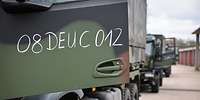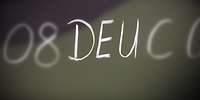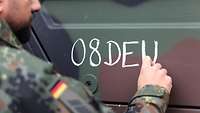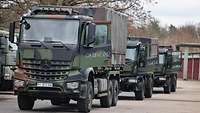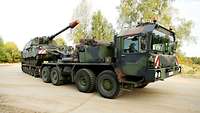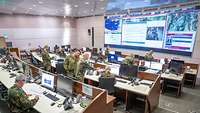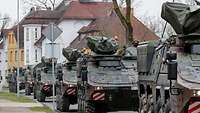Movement credits
Encounters with vehicles of the Bundeswehr or allied armed forces are a regular occurrence on German roads. Blue flags on the left side of the vehicles, the hazard warning lights turned on and a green flag on the last vehicle – march columns are pretty easy to identify. But what do the white characters on the sides actually mean?
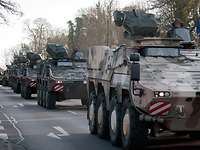
Road movements involving more than ten military vehicles or individual vehicles whose total weight, axle loads or dimensions exceed legally approved limits require a specific authorisation for the use of public roads: they need a movement credit. They put more strain on the roads than usual, leading to excessive road wear. Such authorisation is also necessary for the transport of dangerous goods for which routeing is required in accordance with Section 35(b) of the Ordinance on the Transport of Dangerous Goods by Road, Rail and Inland Waterways. Examples include transporting at least 254 antitank mines or two missiles for the PATRIOTPhased Array Tracking Radar to Intercept on Target air defence system.
The agency in question submits a request for a movement credit to the Bundeswehr Logistics Centre in Wilhelmshaven. The Centre reviews the request for completeness and compliance with the regulations, directives, laws and the civilian road authorities’ requirements. These include, for example, requirements on the transport of dangerous goods, the roadworthiness of vehicles or noise control, as well as the current conditions on German roads.
After that, the Logistics Centre will issue the written movement credit, i.e. the authorisation for the movement. Vehicles that weigh more than 40 tonnes, are wider than 2.55 metres or higher than four metres, for example, may only drive on German roads with an appropriate permit from the civilian authorities. It may not be possible to pass through narrow parts of the road, construction sites, bridges or underpasses due to their insufficient dimensions or limited load capacity. Accordingly, the Bundeswehr Logistics Centre uses the movement credit to provide drivers with the exact route they have to follow. Existing requirements for heavy transports, for example, are monitored in consultation with the military police and, if necessary, with the civilian police.
In general, a new request must be submitted for each movement, as the combination of vehicles, the type and scope of transported defence material or hazardous goods, and start and destination change every time.
What are the elements of a movement credit?
Each movement credit is given a number assigned specifically to this movement. Prior to departure, this movement credit number is written on both sides of each motor vehicle, usually with white chalk, as it can be easily washed off immediately after the end of the movement. The number consists of four different components containing information on the date and nationality of the unit moving.
Driving with a movement credit
The Bundeswehr Logistics Command not only determines the exact route and time of movement, but also defines general instructions and special requirements for the planned route, such as a night driving ban where certain roads or sections of roads may not be used between 10 p.m. and 6 a.m., or other particular constraints for the transport of dangerous goods. The march column or the individual vehicles to which a movement credit has been granted must adhere to these requirements. There is no leeway.
The logistics specialists have generally already identified the most favourable and shortest route in cooperation with civilian authorities and have planned it so that, if possible, no two march columns use the same route at the same time. When completing their preparations, drivers must, on this basis, ensure that they comply with the ordered departure time in order to both pass through specified transit points and reach their destination on time. Any delay could disrupt the process.
Deviation from even one of the specifications could result in the need for a new movement credit. This is the case, for example, if a heavy goods transport is to transport a Puma armoured infantry fighting vehicle to another Bundeswehr location instead of a Leopard 2 A6 main battle tank. Although both vehicles are tanks, they do not match either in their dimensions or in their weight, so the existing movement credit does not cover such a change.
If there is an accident on the road or a vehicle breaks down, the unaffected vehicles will continue their movement. The broken-down vehicle remains on site until it has been repaired by a repair team and is able to continue the movement alone. If repair on site is not possible, the broken-down vehicle will be transported to the nearest appropriate Bundeswehr facility. In this case, the movement credit number stays the same.
Even though requesting movement credits initially generates additional administrative work, they offer major advantages. They provide drivers with greater reliability and safety during planning and actual transport, which prevents obstructions for normal road traffic. Additionally, they are also considered in the determination of road loads, which allows for timely maintenance.


